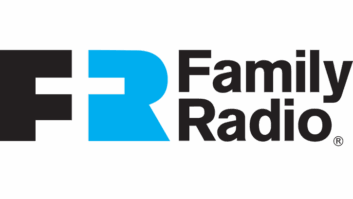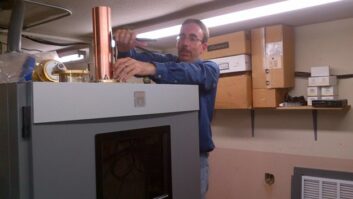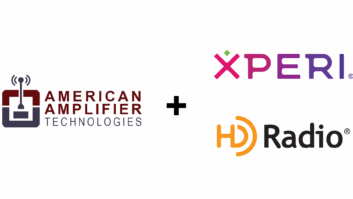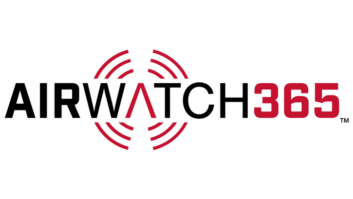PRODUCT CAPSULE
(click thumbnail)
Audemat-Aztec Goldeneagle HD
THUMBS UP:
Full range of testing and measurement
User-configurable for testing, monitoring
Spectrum monitor option
Strong RDS monitoring capabilities
THUMBS DOWN:
Not easy to work through menus and software
Figuring out remote control, telemetry and status reporting capabilities was difficult
PRICE: $7,435
CONTACT:
Audemat-Aztec in Miami at (305) 249-3110 or visit www.audemat-aztec.com.
The Audemat-Aztec Goldeneagle HD is a single-box solution to transmitter monitoring and control, an eclectic combination of HD and analog monitoring and remote control gadgetry. It is a well-constructed, tightly shielded box, capable of performance in virtually any RF environment. It is a comprehensive collection of transmitter monitoring functions, remote controls, telemetry and data monitoring functions.
The spectrum monitor option affords a visual check of a transmitter’s passband. The background masks allow rapid visual checking to assure that all is well. For radio transmitter control, telemetry, alarms and monitoring, the Goldeneagle HD is impressive.
Three versions of the unit are available: Goldeneagle HD FM, Goldeneagle HD AM and the Goldeneagle HD AM/FM. I tested the Goldeneagle HD AM/FM.
It can be configured for installation at a transmitter site, where it would be set up to monitor and control the site; to monitor a transmitter at the studio location; and to log parameters over time, allowing the reports to become part of a log. It also can be configured to monitor parameters and report them via e-mail or phone if something falls out of range.
Goldeneagle HD’s monitoring capabilities address the concerns of today’s radio stations. For example, if something falls outside limits, the GoldenEagle HD e-mails the engineer. Overmodulating only a little? Transmitter power sagging slightly? Dynamic PS hasn’t updated for two hours? Nobody can hear the problem, as they are not really listening all that closely. The chief may be eating lunch with his girlfriend when he receives the alert on his BlackBerry. He knows of the problem before anyone notices that it is a problem, and can deal with it before people tune out.
Out of the box
The Goldeneagle HD monitors key parameters in the modulation envelopes of HD and analog radio signals. It has alarm functions that can be customized, and has programmable remote control and monitoring capability. It can be set up to monitor and control several stations or one. And its core is a computer, which allows for IP or dial-up connectivity and configuration to do a large array of tasks.
Goldeneagle HD calls specified telephone numbers and leaves messages on a schedule, or in response to an alarm. The DTMF option can be used for control functionality if that is needed, as well. The unit is equipped to monitor AM and FM analog as well as HD, and is equipped with AM and FM spectrum analysis capability.
Importantly, it has a graphical interface on the front panel that, once configured by the administrator, makes monitoring easy enough for a non-technical jock or GM to read.
I had no trouble making the unit work straight out of the box, but I did have a bit of fun learning about the things it will do. I set it up at my office and browsed to it from home, where I listened to streaming audio from the unit. Running the associated software, I looked at the front panel remotely, and played with control functions remotely via the Web.
The front panel enables the setting of several management functions, type in the frequency of a station you want to monitor and select a pre-programmed station for monitoring. Bring up a modulation monitor, and listen to audio as transmitted. The front exhibits the spectrum display in units equipped with the spectrum monitor.
It was difficult to work through the menus and software to locate the machine’s capabilities, and I had an especially difficult time figuring out how to utilize the remote control, telemetry and status reporting capabilities. They were not especially obvious. In a future version of the unit, I would like to be able to drill into this from the front panel, assigning control functions and calibrating metering from there.
The unit offers 16 control functions, 16 metering channels and 16 status channels. A simple radio transmitter site will not use all of these; but this could be a bit light for a complex site involving main and standby transmitters for more than one station, environmental control and monitoring, and status reporting for such things as doors, interlocks and so on.
I listened to and looked at the technical parameters of several radio stations in the Denver area. All were in compliance with the spectrum masks, even though some stations modulated more heavily than others. Curiously, the public stations did not push the envelope on modulation level, but the commercial stations did — every one of them.
One station never modulated under 100 percent except during silence, at least as far as the display was concerned. Based on the display, I thought this station’s audio was probably overprocessed. When I listened, there was no question about it. There was a lot of audio ducking on heavy bass, and there was a lot of heavy bass due to the station format. It was like taking a beating to listen to it. What was really interesting about this was that I was able to visually identify this from the Goldeneagle HD display.
Management tools are available by browsing to the unit. Among the tools are log-in and password setup, IP parameters setup, phone alerts, SNMP parameters and so on. I discovered I could check such stuff as the CPU temperature (36.8 degrees Celsius) via the external computer. You can even turn the Goldeneagle HD off remotely.
The Goldeneagle HD also comes with monitoring management software, also called Goldeneagle HD. With this software, users get a remote peek at the same screens available on the front panel, and a bunch more. The menus are self-explanatory, allowing you to configure what you want to monitor, set alarm parameters and view alarms and do real-time monitoring of signal parameters.
Setup is best done with the manual open, because the alarm parameters need a bit of explanation. I had a great time playing with these, tweaking and fine-tuning things until it worked the way I wanted it to work.
The spectrum display shows real-time occupied bandwidth information for the transmitted signal, and includes masks to cross-check the signal to assure the bandwidth is legal. Goldeneagle HD monitors the important signal parameters of your analog signal and your digital signal, and displays graphs of these over the past hour or over the past day.
The RDS monitoring capabilities are strong. If your station uses static PS, Goldeneagle HD alerts you if the PS changes. If you are using dynamic PS, it can alert you if it fails to change in a given amount of time. This is just one of the critically important parameters that decide whether you keep or lose your audience, and is something that no station should be without. There are a lot of things to check in the HD Radio environment, and Audemat-Aztec has packed the necessary tools to do so into the unit.
I was successful in streaming audio from the Goldeneagle HD to my laptop, where I could select high or low streaming quality. I could not hear a difference on my laptop speakers, so I left it on low and listened to radio on my laptop a bit while I wrote this article. With streaming audio, you can listen to the analog program alone, one of the digital programs alone or you can listen to the digital main in the left channel while you listen to analog main in the right channel.
I have not been able to figure out why you’d want to listen to Rush Limbaugh in one ear while listening to a basketball game in the other, but if that is what is on the air at the moment, you could do just that.
HD Radio presents new challenges to stations. A great number of these challenges are technical in nature, and are critical to acquiring and holding an audience. In addition to providing conventional transmitter site monitoring and control, the GoldenEagle HD monitors the important additional parameters necessary to this end. It also notifies the engineer of problems before they ever become evident to the listening audience. This heads-up notification ability can make the difference with audience numbers.
Even though the unit was expensive, I thought it was priced right for the capabilities it had. By comparison to purchasing separate instruments to replace its functions, it is very affordable. And I cannot imagine that something with similar capabilities, aimed at television transmitter sites, would not be enthusiastically received.








